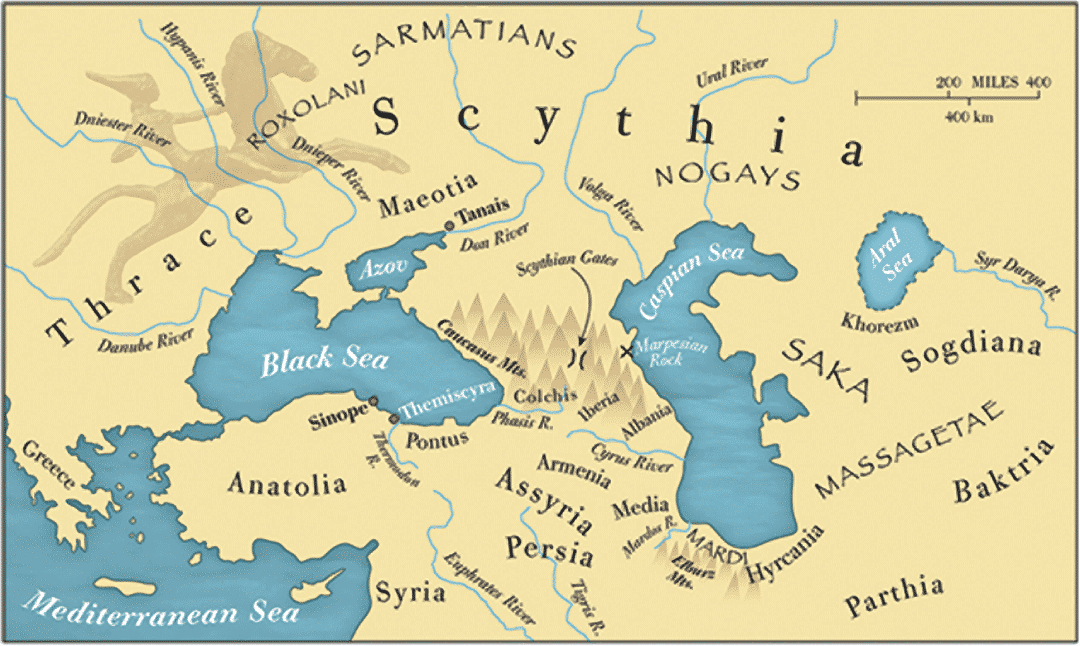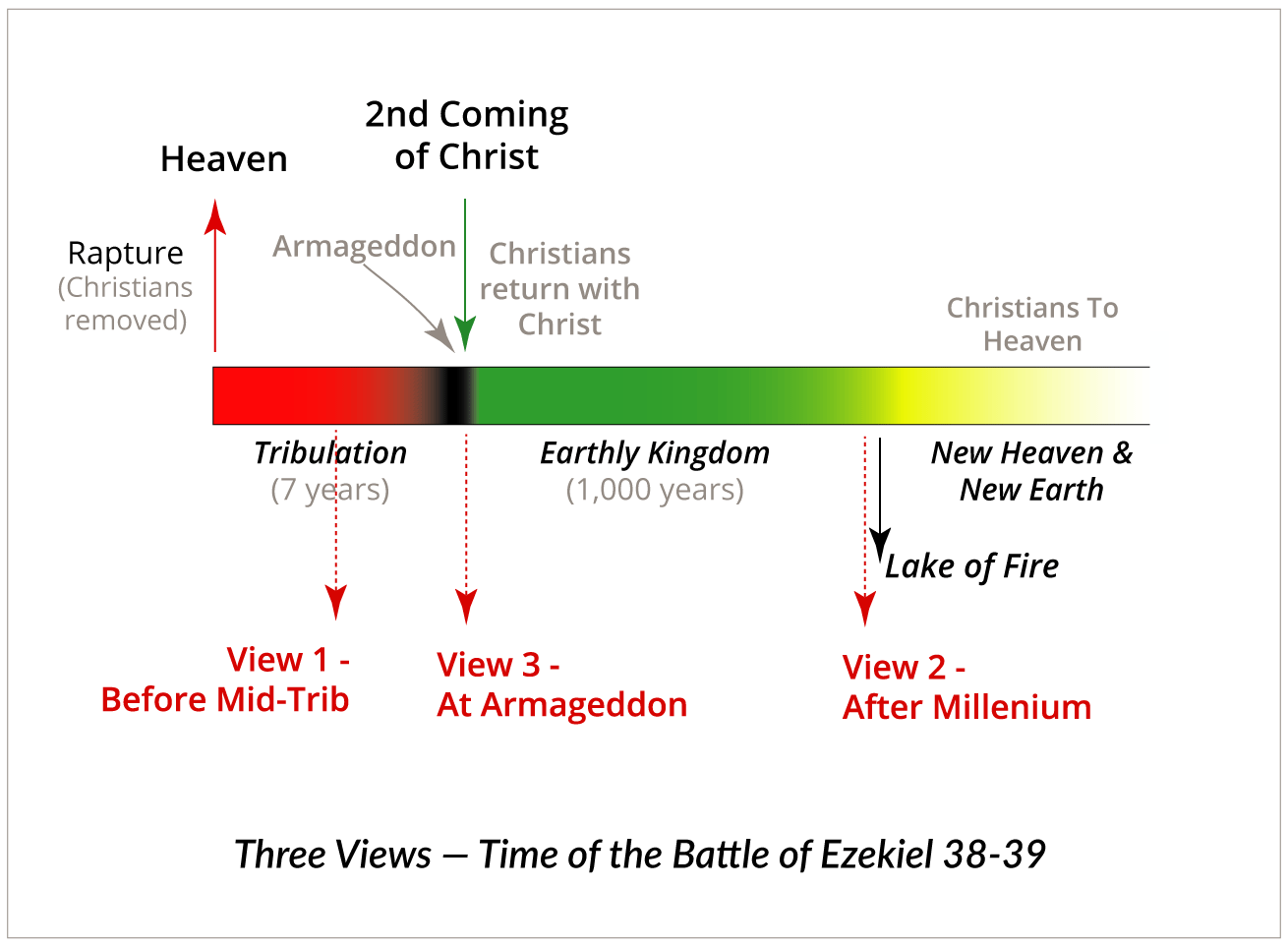Bible Question:
2 Thessalonians 2 makes it clear that the lawless one will be revealed and destroyed at Christ's coming. One might say that the lawless one is a man or a prophet (being in the flesh) but it is also Satan. If Satan is bound for 1,000 years and then released after the 1,000 years for a short moment, does this mean that the battle with Gog and Magog will not take place before the coming of the Lord? Compare Revelation 20:7-10.
Bible Answer:
Many Christians who want to understand God’s plans for our future are interested in various details found in Scripture about the tribulation and the battle of Armageddon. One of those details is, “Does the battle of Gog and Magog occur after the Second Coming?” The answer to the question is found in Ezekiel 38-39 which describes multiple armies that come from the north and invade Israel during the battle of Armageddon. What follows explains this answer.

Definition of Gog and Magog
It is common to refer to Ezekiel 38-39 as the battle of Gog and Magog. However, Ezekiel 38:2 and Ezekiel 39:1 reveal that Gog will be the leader of a nation referred to as Magog.
Son of man, set your face toward Gog of the land of Magog, the prince of Rosh, Meshech and Tubal, and prophesy against him . . . Ezekiel 38:2 (NASB)
According to Flavius Josephus the land of Magog was the land of the Scythians.[1] The Scythians occupied the territory north of the Black Sea.[2] The church father Jerome writes,
“Scythian nations, fierce and innumerable, who live beyond the Caucasus and the lake Maeotis, and near the Caspian Sea, and spread out even onward to India.”[3]
Today, this territory is occupied by Russia, which lies to the north of Israel. Legend states that the Scythians had a reputation for being anti-religion.[4] This would be significant since modern day Russia has been anti-religion. Has this always been true? We believe that the other nations of Rosh, Meschech, Tubal (v. 2-3) and Gomer and Beth-togarmah (v. 40) were all located in the north territory, along with the Scythians.[5] The location of the nations of Ethiopia and Put are uncertain,[6] but the nation of Persia corresponds to modern day Iraq and Iran.[7] All of these nations then, except for possibly Ethiopia and Put, are all located north of Israel.
Does the Battle of Gog and Magog Occur After the Second Coming?
There are several views as to when the events described in Ezekiel 38-39 occur. Three are three views as to when the so-called battle of Gog and Magog will occur. The first view says the battle will occur in the middle of the tribulation, during the battle of Armageddon, and after the millennial kingdom. What follows is an explanation of all three views.

First View – Ezekiel 38-39 Occurs Mid-Tribulation
The first view states that the events of Ezekiel 38-39 begin before or at the middle of the tribulation. This view believes that Ezekiel 38:10-13 describes a time of peace. Since the first half of the seven-year tribulation is a time of peace, supporters of this view reason that Ezekiel 38-39 will occur in the middle of the tribulation.
But there are two reasons to reject this view. First, Ezekiel 38 describes only plans and not a battle (Ezekiel 38:10). The only clear statement in Scripture about an invasion of Israel is at the end of the tribulation. That is the message of Revelation 16:13-16; 19:11-21. To postulate another invasion prior to Armageddon is problematic. First, Ezekiel 38-39 would be the only biblical reference and the description of the invasion is more closely in agreement with View #3.
The second reason to reject this view is that Ezekiel 39:11, 15 refers to the valley of Hamon-gog as the place of the battle. Ralph H Alexander, author of Ezekiel in The Expositor’s Bible Commentary makes this statement about the valley of Hamon-gog,
The only valley to fit remotely this description would be the Esdraelon Valley in the lower Galilee.[8]
That is, the Esdraelon Valley is the only one that can even possibly fit the description in Ezekiel 39:10-14. The Esdraelon Valley is also called the Campus Legionis, Esdraelon, Plain of Megiddo, Plains of Megiddo, Great Plain, Great Plain of Esdraelon, Great Plain of Megiddo, Merj ibn-‘Amir, Plain of Megiddo, The Valley, and the Valley of Megiddon[9]
It is clear from Zechariah 12:11 that the battle of Armageddon will occur in the Valley of Megiddo. Consequently, Scripture connects the battle in the valley of Hamon-gog to the Valley of Megiddo which is where the battle of Armageddon will occur.
This agrees with the name of the battle location mentioned in Revelation 16:14 which is Har-Magedon, also called Armageddon. Revelation 19:11-21 gives us a summary overview of the battle which occurs just before the millennial kingdom is set up in Revelation 20:4-6. Since the descriptions correspond so closely with the final battle at Armageddon, this argues against a mid-tribulation view for the battle of Ezekiel 38-39.
Second View – Ezekiel 38-39 Occurs After The Millennium
The second view says that Ezekiel 38-39 describes the battle that occurred after the millennial kingdom in Revelation 20:7-10. A major point in support of this view is that Revelation 20:7-10 refers to God and Magog engaging in battle after the millennial kingdom.
And when the thousand years are completed, Satan will be released from his prison, and will come out to deceive the nations which are in the four corners of the earth, Gog and Magog, to gather them together for the war; the number of them is like the sand of the seashore. And they came up on the broad plain of the earth and surrounded the camp of the saints and the beloved city, and fire came down from heaven and devoured them. And the devil who deceived them was thrown into the lake of fire and brimstone, where the beast and the false prophet are also; and they will be tormented day and night forever and ever. Revelation 20:7-10 (NASB)
But there are two reasons to reject this view. First, we are told that Satan will be influential enough to deceive all the nations of the world into attempting to destroy the beloved city or Jerusalem. On this occasion there is nothing left of the invading armies after fire descends from heaven and consumes all of the armies. The Greek word for “devoured” supports this conclusion, since it is katesthio, which means “to completely destroy.” That is, there is nothing left of the armies and weapons. But Ezekiel 39:9-14 states that Israel will be destroying the weapons and dead bodies. This is a major problem for this view.
A second major reason to reject this view is that Ezekiel 39:9-10 states that Israel will spend seven years destroying the weapons from the battle and taking spoils, and seven months burying the corpses of the dead army soldiers (Ezekiel 39:11-14). Why would God give the nation of Israel seven months to bury dead soldiers after the millennium, when the universe will be destroyed and then immediately the great white judgment will occur (Revelation 20:11-15)? Therefore, this view is rejected.
Third View – Ezekiel 38-39 Occurs At the End of The Tribulation
The final and correct view is that Ezekiel 38-39 corresponds to the events that will occur at the battle of Armageddon. While Daniel 11:44-45 describes the actions of nations from both the east and north, it seems best to conclude that Ezekiel provides additional information about the invading northern nations. The description of Ezekiel 38-39 also corresponds closely with Revelation 19:11-19.
The first reason is that Ezekiel 38:1-39:20 more accurately describes the battle of Armageddon described in Revelation 16:13-16 and Revelation 19:15, 17-19. Ezekiel 38 describes the nations involved in the battle; yet, the battle is motivated by Gog. Gog is the leader of Magog. It appears that he is the king of the North in Daniel 11:44-45. That passage is about the battle at Armageddon.
Second, Ezekiel describes the battle and the final outcome. Ezekiel 38:16 and chapter 39:1-2 says that Gog will invade and surround Israel. Ezekiel 39:3-6 says Gog will be defeated and Ezekiel 39:17-20 states the birds will eat the flesh of the armies. Here is a brief comparison of Ezekiel 39 to Revelation 16:13-16 and Revelation 19:15, 17-19.
1. Armageddon Involves All the Nations — Ezekiel 38:15-16; 39:7 and Revelation 19:19
2. Battle Occurs in Har-Magedon — Ezekiel 39:11, 15 and Revelation 16:16
3. Birds Will Eat the Flesh of the Soldiers — Ezekiel 39:17, 19-20 and Revelation 19:15, 17-18
4. Gog and Other Leaders Killed — Ezekiel 39:1, 11 and Revelation 19:19-20:3
5. God Will Be Glorified — Ezekiel 39:13, 21 and Revelation 19:7-16
6. Millennial Kingdom Follows — Ezekiel 39:21-29 and Revelation 20:4-6
Third, the seven years of taking spoils (Ezekiel 39:9-10), and the seven months of burying the corpses of the dead army soldiers (Ezekiel 39:11-14) will occur at the beginning of the millennial kingdom. There are no timeline problems.
Conclusion:
Daniel 11:40-45 describes a series of battles preceding and including the battle of Armageddon. It gives us the most complete picture of the battles at the end of the tribulation. However, Ezekiel 38-39 describes the activities of the king of the North, specifically Gog, and the other nations that join in battle. The book of Revelation provides a series of snapshots of other events leading up to and including the battle of Armageddon (Revelation 9:13-21; 16:13-21; 19:7-20:3. Joel 3:1-16 paints another quick overview. Zechariah 12-14 provides a series of snapshots about the tribulation and the second coming of Christ.
The book of Revelation is a prophecy that everyone should read. It is the word of the Lord!
Blessed is he who reads and those who hear the words of the prophecy, and heed the things which are written in it; for the time is near. Revelation 1:3 (NASB)
It describes the Second Coming of Jesus, the judgments of every man and woman, and where each of us will spend eternity. Come quickly, Lord Jesus! Come!
References:
1. Flavius Jospehus. Book 1, Chapter VI, Section 1. Josephus. Kregel Publications. 1960. p. 31.
2. William Langer. The Encyclopedia of World History. Houghton Mifflin Co. 2001. p. 17.
3. McClintock and Strong. Cyclopedia of Biblical, Theological, and Ecclesiastical Literature. 1881. vol. V. p. 653.
4. Ibid.
5. John Walvoord. The Prophecy Knowledge Handbook. Dallas Seminary Press. 1984. pp. 191-192.
6. Ibid., p. 192.
7. Ibid., p. 192.
8. Ralph H Alexander. Ezekiel. The Expositor’s Bible Commentary. Regency Reference Library. 1986. . p. 936.
9. Bible Places. Jezreel Valley.
Suggested Links:
What is the Battle of Armageddon? Which nations will be there?Armageddon Is Coming
The Future Antichrist and the Battle of Armageddon
Daniel’s Seventy Weeks and The Tribulation
What are the 7 seals, 7 trumpets, 7 signs and 7 bowls of Revelation?
Does the rapture occur before the tribulation period?
How can we know who is the antichrist?
Will war occur before Gog and Magog are defeated in Ezekiel 38-39?